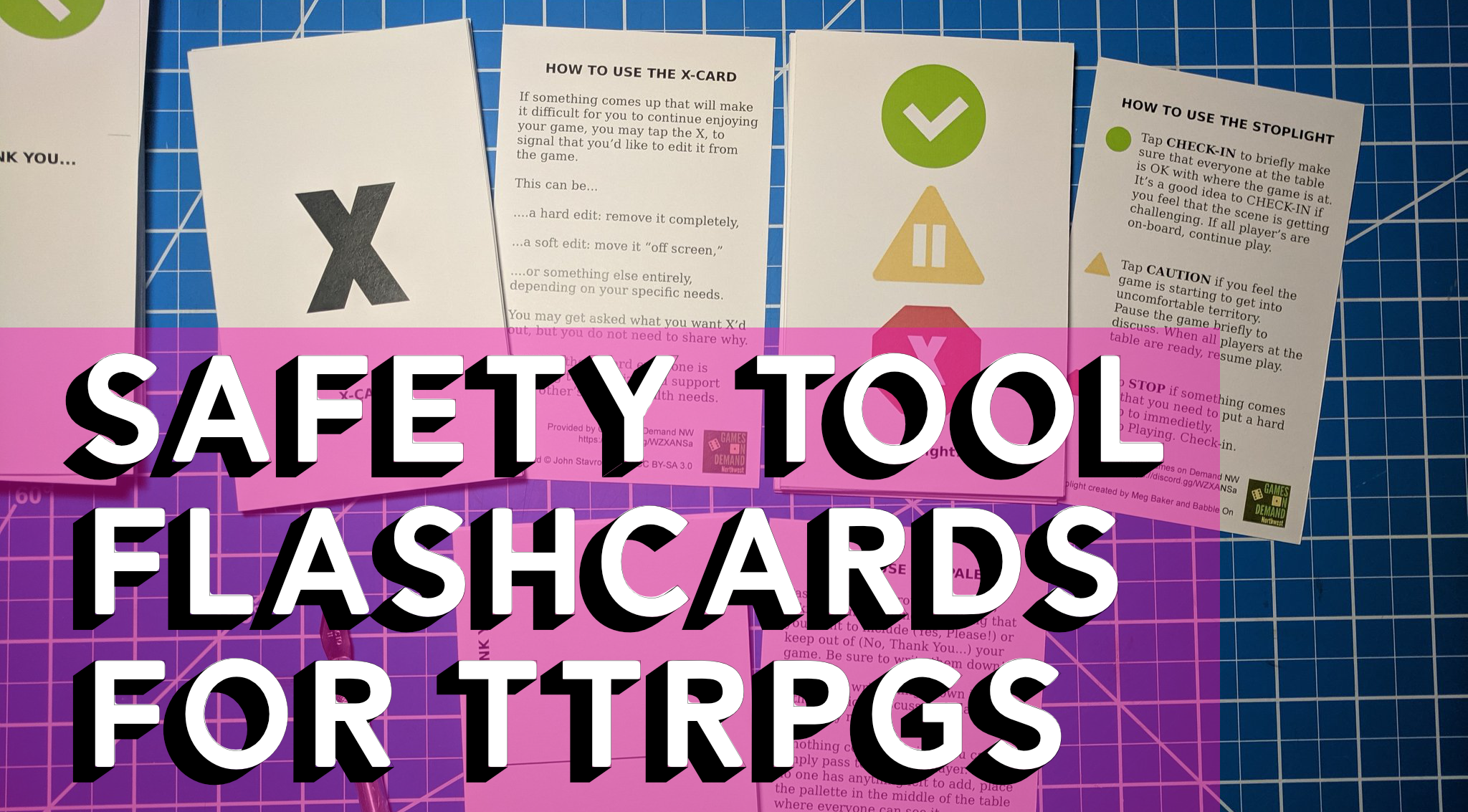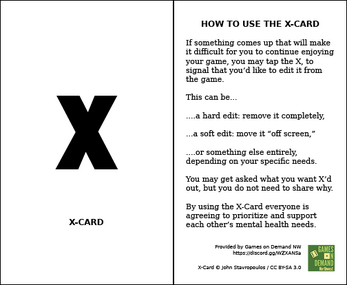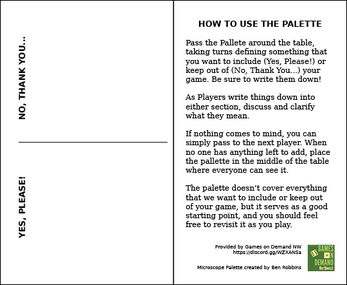
Safety Tool Cards for TTRPGs
A downloadable gaming tool
Originally created for GoPlay NW, this collection of TTRPG Safety Tools gives you print-at-home versions of several different tools, allowing you to keep them close at hand and choose the tool the best fits your group's needs.
You're welcome to print and use these cards for your personal table, live stream, or next big event.
What's Included?
Cards are included for the following safety tools.
The X-Card
Probably the most well known ttrpg safety tool out there, John Stavropoulos's X-Card is familiar and easy to include even on a table crowded with lots of other things. While the use of the card itself has lots of different meanings, it is mostly used to indicate that something has made someone at the table uncomfortable and that they would like to remove that content from the game. You can read more about the X-Card here.
The Stoplight
The Stoplight takes a various possible uses of the X-Card and breaks them into three different symbols to help facilitate more explicit communication about your needs at the table: The Check-In provides an easy nonverbal way to make sure everyone is comfortable, Caution informs the table they are approaching a sensitive topic and should discuss that, and Stop provides an emergency break when a boundary has been crossed and a serious conversation or break is needed. The Stoplight was originally created by the Babble On Equity Project and Meg Baker..
Two variations of the Stoplight are included in this collection:
- The first version includes all of the symbols on a single card for use at a physical table
- The second version separates each of the symbols onto their own card that can be held-up and shown to a camera for virtual events or at a table as needed.
The Palette
Originally part of the world-building set-up phase for Ben Robbins' epic history exploration game, Microscope. The Palette expands the conversation around safety by framing the conversation around what folks WANT and DON'T WANT to see in the game. This allows players to focus on the tone and content they are excited about seeing, while turning the "No" list into a conversation about more than just a player's personal boundaries; you don't need to distinguish between whether or not you added something to the "No" list because it's a personal trigger or because it's just a theme you don't want to explore for that specific game.
Two versions of the Palette are included:
- a printable version you can write on directly at your table,
- and a digital version for use with a virtual table top.
Pause/Retcon/Fade-to-Black
Pause/Retcon/Fade-to-Black were originally created by Star West for use in Wanderlust. These tools facilitate safety while framing the conversation around collaborative editing of the fiction. They encourage regular use at the table, helping to normalize an ongoing conversation about the fiction, rather than treating their use like something that's only there for emergencies.
Two variations of Pause/Retcon/Fade-to-Black are included in this collection:
- The first version includes all of the symbols on a single card for use at a physical table
- The second version separates each of the symbols onto their own card that can be held-up and shown to a camera for virtual events or at a table as needed.
Q&A
Why did you choose these safety tools?
There are a lot of different safety tools out there, and we encourage you to use the tools that work best for your table's needs. We chose these tools because we personally prefer them, and because many of the other tools out are already available in a printable format.
The X-Card is probably the most recognizable safety tool out there, and while it is not our preferred tool, it's one that nearly everyone sitting down at GoPlay NW (the event we created these cards for) is already familiar with.
When given the choice, we prefer the more nuanced approach of the Stoplight over the X-Card. While John describes multiple uses for it, most people treat the X-Card as being explicitly for removing something from the game; the Stoplight give folks more explicit ways to express their needs with less ambiguity.
The Palette does what Lines and Veils does, but in a less risky way. Lines and Veils frames the conversation explicitly around boundaries, and it can feel very intimidating to share your personal triggers with everyone at the table. Instead, the Palette frames the conversation around what content or themes folks are excited about and not excited about exploring; it makes the conversation about the game content rather than anyone's personal vulnerabilities.
Similarly, Pause/Retcon/Fade-to-Black provide an ongoing to way facilitate conversation around the fiction in an open, friendly, and approachable way. You can Pause or Retcon the game for any reason in order to create more exciting and interesting fiction, not just because of uncomfortable content. These tools encourage their ongoing use throughout play rather than being treated like something that should only be used in emergencies (I personally have seen folks more readily use Pause/Retcon/Fade-to-Black than any other safety tool at my table.) They also cover most of the same ground as Beau's Script Change while using fewer pieces.
Can you add a [Name of Safety Tool]?
Sure! If there's a specific tool you'd like to see added, let me know in the comments. I can't promise or guarantee when I'll get to it, but I can try. In cases where there's a specific known creator, I might ask that you have them contact me directly.
Why use cards? Shouldn't folks just speak up if they have a problem?
Every table and play group is different, so if having a verbal way to facilitate that conversation works for you—go for it! That said, there are a many reasons having a non-verbal and physical way to facilitate these conversations can be really helpful.
- Having a physical object on the table turns it into a "game piece." Even if players aren't using it, serves as a reminder and makes it a more real part of the game, just like your character sheets, maps, minis, and other tools.
- We teach folks that "interrupting others" is bad, so when you're in the unenviable position of having to speak up for your needs (and possibly feeling like you might be stopping someone else's fun in the process,) having an established tool you can use with a mechanical purpose helps to make sure no one gets stuck having a bad time.
- Having a nonverbal tool you can hold up lets you inform the table of your needs without having to try and speak over someone else who might be speaking.
- The ability to non-verbally indicate the need for an out-of-character conversation is especially important in spaces that highly value "immersion." If your play table frowns on speaking OOC you should consider having an explicit and safe way to do that.
How can I learn more about safety tools?
The TTRPG Safety Toolkit by Kienna Shaw and Lauren Bryant-Monk provides an excellent discussion about the value of safety tools and provides a primer on several of the most well known tools available; it also includes its own set of printable cards for several of the tools it describes. There is also @rpgnatalie's excellent article "Safety Tools Compilation."
You can learn more about specific tools through the websites of the creators for those specific tools, such as John's X-Card and Beau's Script Change. And several articles have been written about other tools, such as the Support Flower, Thorns and Roses, the O-Card, and many others.
Some of the best safety tools out there are designed directly into the game's mechanics, so keep an eye out for the way designers incorporate rules that facilitate consent and ownership of the fiction in their games.
| Status | Released |
| Category | Physical game |
| Rating | Rated 5.0 out of 5 stars (15 total ratings) |
| Author | Star West |
| Tags | Print & Play, resource-pack, Project template, tools, Tabletop role-playing game |




Comments
Log in with itch.io to leave a comment.
Thank you so much for addressing here how the x-card has been abused x.x I have my own horror stories with it.
Palette seems like an interesting option vs Lines and Veils. I'm a huge fan of LaV, but the tables I've been at turn the lists directly to the GM so no one else needs to know, so we can be open and honest without feeling any embarrassment. I thought that practice was the norm, and I'm surprised it isn't for the very reason you prefer Palette.
You have done the world a service
These are perfect! Thank you so much!
Thank you! I'm glad you liked them.